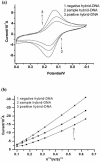Detection of methylation of human p16(Ink4a) gene 5'-CpG islands by electrochemical method coupled with linker-PCR
- PMID: 12907744
- PMCID: PMC169984
- DOI: 10.1093/nar/gng092
Detection of methylation of human p16(Ink4a) gene 5'-CpG islands by electrochemical method coupled with linker-PCR
Abstract
Aberrant DNA methylation of the CpG site is among the earliest and most frequent alterations in cancer. Detection of promoter hypermethylation of cancer-related genes may be useful for cancer diagnosis or the detection of recurrence. p16, an inhibitor of the cyclin D-dependent protein kinases, is a classical tumor suppressor gene, and its inactivation is closely associated with carcinogenesis. p16 hypermethylation could be detected in each stage, which is consistent with the finding that aberrant methylation of p16 is a very early event in carcinogenesis. We have developed an electrochemical procedure for detecting DNA methylation of the human p16(Ink4a) gene. The procedure is based on the coupling of DNA electrochemical sensors with linker-PCR- amplified DNA from human gastric tumor tissue and whole blood cells of healthy human. The synthesized oligonucleotide was immobilized on the modified gold electrode to fabricate a DNA biosensor. The hybridization reaction on the electrode surface was monitored by cyclic voltammogram (CV) and square wave voltammogram (SWV), using [Co(phen)(3)](ClO(4))(3) as a redox indicator. Methylation status of human p16(Ink4a) gene was detected and the results were validated by bisulfite DNA sequencing. A good reproducibility was observed in several parallel experiments. The coupling of DNA electrochemical sensors with PCR allowed quick detection and have the potential of the quantitative evaluation of the methylation status of the human p16(Ink4a) gene.
Figures





Similar articles
-
A microarray to analyze methylation patterns of p16(Ink4a) gene 5'-CpG islands.Clin Biochem. 2003 May;36(3):197-202. doi: 10.1016/s0009-9120(02)00445-9. Clin Biochem. 2003. PMID: 12726928
-
Up-regulation of expression and lack of 5' CpG island hypermethylation of p16 INK4a in HPV-positive cervical carcinomas.BMC Cancer. 2007 Mar 14;7:47. doi: 10.1186/1471-2407-7-47. BMC Cancer. 2007. PMID: 17359536 Free PMC article.
-
Germline promoter hypermethylation of tumor suppressor genes in gastric cancer.World J Gastroenterol. 2012 Jan 7;18(1):70-8. doi: 10.3748/wjg.v18.i1.70. World J Gastroenterol. 2012. PMID: 22228973 Free PMC article.
-
Gene methylation in gastric cancer.Clin Chim Acta. 2013 Sep 23;424:53-65. doi: 10.1016/j.cca.2013.05.002. Epub 2013 May 10. Clin Chim Acta. 2013. PMID: 23669186 Review.
-
Quantitative assessment of aberrant P16INK4a methylation in ovarian cancer: a meta-analysis based on literature and TCGA datasets.Cancer Manag Res. 2018 Aug 29;10:3033-3046. doi: 10.2147/CMAR.S170818. eCollection 2018. Cancer Manag Res. 2018. PMID: 30214298 Free PMC article. Review.
Cited by
-
Electrochemical determination of the activity of DNA methyltransferase based on the methyl binding domain protein and a customized modular detector.Mikrochim Acta. 2019 Mar 8;186(4):229. doi: 10.1007/s00604-019-3309-9. Mikrochim Acta. 2019. PMID: 30848391
-
Microarray-based method for detecting methylation changes of p16(Ink4a) gene 5'-CpG islands in gastric carcinomas.World J Gastroenterol. 2004 Dec 15;10(24):3553-8. doi: 10.3748/wjg.v10.i24.3553. World J Gastroenterol. 2004. PMID: 15534905 Free PMC article.
-
Methylation-driven gene DLL3 is a potential prognostic biomarker in ocular melanoma correlating with metastasis.Front Oncol. 2022 Oct 20;12:964902. doi: 10.3389/fonc.2022.964902. eCollection 2022. Front Oncol. 2022. PMID: 36338696 Free PMC article.
-
Electrochemistry of nonconjugated proteins and glycoproteins. Toward sensors for biomedicine and glycomics.Chem Rev. 2015 Mar 11;115(5):2045-108. doi: 10.1021/cr500279h. Epub 2015 Feb 9. Chem Rev. 2015. PMID: 25659975 Free PMC article. Review. No abstract available.
References
-
- Baylin S.B., Herman,J.G., Graff,J.R., Vertino,P.M. and Issa,J.P. (1998) Alteration in DNA methylation: a fundamental aspect of neoplasia. Adv. Cancer Res., 72, 141–196. - PubMed
-
- Valenzuela M.T., Galisteo,R., Zuluaga,A., Villalobos,M., Nunez,M.I., Oliver,F.J. and Ruiz,J.M. (2002) Assessing the use of p16INK4a promoter gene methylation in serum for detection of bladder cancer. Eur. Urol., 42, 622–630. - PubMed
-
- Esteller M., Montserrat,S.C., Rosell,R., Sidransky,D., Baylin,S. and James,G.H. (1999) Detection of aberrant promoter hypermethylation of tumor suppressor genes in serum DNA from non-small cell lung cancer patients. Cancer Res., 59, 67–70. - PubMed
Publication types
MeSH terms
Substances
LinkOut - more resources
Full Text Sources
Other Literature Sources

